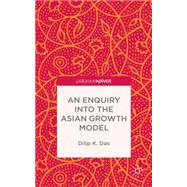An Enquiry into the Asian Growth Model

An Enquiry into the Asian Growth Model
- ISBN 13:
9781137529268
- ISBN 10:
1137529261
- Format: Hardcover
- Copyright: 04/13/2015
- Publisher: Palgrave Pivot
Rent
Sorry, this item is currently unavailable on Knetbooks.com
Note: Supplemental materials are not guaranteed with Rental or Used book purchases.
Extend or Purchase Your Rental at Any Time
Need to keep your rental past your due date? At any time before your due date you can extend or purchase your rental through your account.
Summary
During the post-World War-II period, several Asian economies turned in stellar performances. They achieved sustained growth with low inequality in a short time span. The term economic 'miracle' was sequentially used for several of them. How they achieve the onerous and elusive goal of rapid and sustained growth when many other regional and global economies could not is the all-important question. This is a serious, intense and meaningful inquiry and has given rise to new and influential theoretical concepts in economics. There are significant differences in economic structures as well as the growth paradigm chosen by each individual Asian economy. However, there are common threads that underlie the differences in development strategies. Export-led growth, government intervention and state-capitalism are among the common policy strands. Asian economies are also known for benign government-business relationship.
Sound macroeconomic fundamentals, disciplined government leadership and intervention are regarded as some of the ingredients of success of the Asian economies. Das argues the dynamic Asian economies maintained high rates of saving and investment, controlled fiscal spending and pursued a government-led export-oriented industrial policy. They consciously maintained high quality education, both primary and secondary, as well as flexible labour markets. Going counter to the grain of neoclassical economic policies, the governments intervened heavily in credit allocation through public and private financial institutions. State was involved in both capital formation and allocation. With supporting policies, this 'winning mix' seemed to work. However, it should be noted that this model was far from perfect. Japan suffered from its vulnerabilities learned in the early 1990s and the other Asian economies in 1997. While the model was successful in mobilizing domestic and international capital, it performed unsatisfactorily in capital allocation. It did not flow to the most productive economic activities.
Sound macroeconomic fundamentals, disciplined government leadership and intervention are regarded as some of the ingredients of success of the Asian economies. Das argues the dynamic Asian economies maintained high rates of saving and investment, controlled fiscal spending and pursued a government-led export-oriented industrial policy. They consciously maintained high quality education, both primary and secondary, as well as flexible labour markets. Going counter to the grain of neoclassical economic policies, the governments intervened heavily in credit allocation through public and private financial institutions. State was involved in both capital formation and allocation. With supporting policies, this 'winning mix' seemed to work. However, it should be noted that this model was far from perfect. Japan suffered from its vulnerabilities learned in the early 1990s and the other Asian economies in 1997. While the model was successful in mobilizing domestic and international capital, it performed unsatisfactorily in capital allocation. It did not flow to the most productive economic activities.








